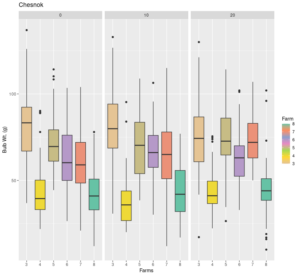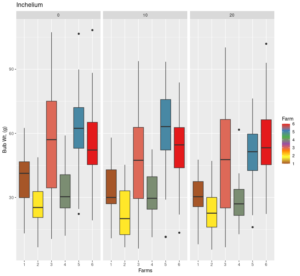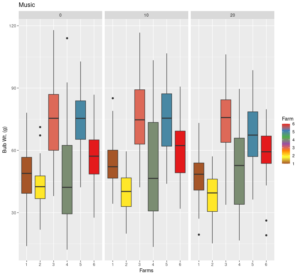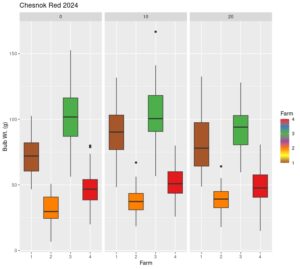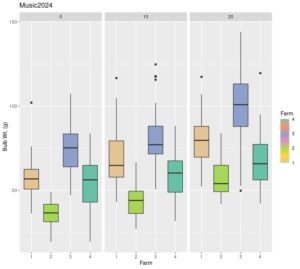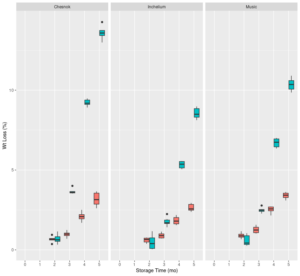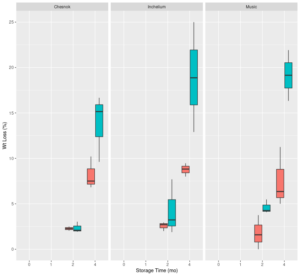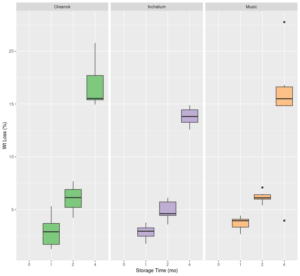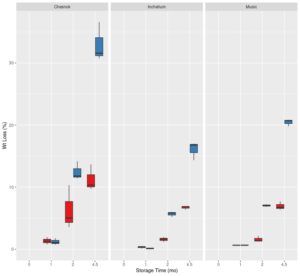Final report for ONC22-115
Project Information
Small-acreage, local vegetable farms provide healthful food, taxable income, and ecosystem services to their communities. This project seeks to help sustain these farms by improving the yield of hardneck garlic, an economically important crop grown on many Minnesota vegetable farms. The project has both preharvest and postharvest components. To offset the increasing unpredictability of cold weather on garlic yield, we tested the effectiveness of preplant vernalization as a supplement to natural field chilling on garlic yield. For three years, ‘Chesnok Red’ and ‘Music’ garlic was vernalized for 10 d or 20 d at 40 F prior to planting at the University of Minnesota and at collaborating farms, and weights of cured bulbs were compared to that of unchilled controls. Vernalization was not effective in the first year, and only effective for ‘Music’ in the second year of the experiment. It may therefore be worthwhile for farmers to vernalize ‘Music’, but not ‘Chesnok Red’ bulbs for 20 d or more prior to planting to hedge against warm winter temperatures. To learn how modern hardneck garlic shelf-life is affected by storage temperature, on-farm and laboratory-controlled comparisons of ‘Chesnok Red’ and ‘Music’ bulb weight loss at 32 F and 40 F were done. Bulbs stored at 32 F lost 5-7% of fresh weight, whereas bulbs stored at 40 F or higher temperatures, lost 35-40% fresh weight. None of the ‘Chesnok Red’ (vernalized or control), while less than 10% of the control and 67% of the vernalized ‘Music’ bulbs that had been stored at 32 F and transferred to room temperature sprouted, by 2 months after the transfer. Bulbs stored at 40 F started sprouting after 9 months while in cold storage. Farmers who are selling garlic for consumption should store garlic at < 40 F, but farmers selling to others interested in planting garlic should store garlic at > 40 F.
The project has two objectives: 1) determine how to adapt vernalization practices used in the southern USA to grow garlic in northern climates, and test the practice on multiple Minnesota farms with different varieties of garlic, and 2) learn how well postharvest storage recommendations translate to actual farming situations and how on-farm postharvest practices affect possible shelf-life at market.
Cooperators
- (Educator and Researcher)
- - Technical Advisor (Educator and Researcher)
- - Technical Advisor (Educator and Researcher)
- (Educator and Researcher)
- (Researcher)
- (Researcher)
- (Researcher)
Research
In 2022 and 2023, ‘Chesnok Red’ seed garlic was purchased from a local producer (Coffman Garlic and Apples, W Concord, MN), while ‘Music’ garlic was procured from Filaree Garlic Farm (Omak, WA). Additionally, the softneck variety Inchelium Red was purchased in 2022 from Filaree Garden Farm.
Garlic bulbs were vernalized for 0 (control), 2, and 4 weeks at 40 F at the University of Minnesota, and distributed to collaborating farms at the end of the chilling treatment. Cloves were planted, mulched, fertilized, irrigated, harvested, and cured according to each farm’s usual practice. After cured bulbs were cleaned and trimmed, 10 bulbs of each variety and vernalization treatment were weighed and sized. In 2022-2023, ‘Inchelium Red’ and ‘Music’ garlic were grown on the Saint Paul campus of the University of Minnesota, and on five MN farms located in Hugo, Maplewood, New Germany, Montrose, and Webster. ‘Chesnok Red’ was grown at the University of MN and on the farms in New Germany, Montrose, and Webster, as well as at locations in Roseville and Zumbro Falls. In 2023-2024, only ‘Chesnok Red’ and ‘Music’ were grown at the University of MN and farms in Maplewood, New Germany and Montrose, with an additional site in Isanti, MN.
On the Saint Paul campus, a randomized complete block design was used for field experiments, with four replicate blocks for each variety x treatment. Garlic was planted with three cloves across a 1-1.5 foot bed, so cloves were spaced about 6 inches apart, with about 21 cloves per subplot. Beds were spaced 2 feet apart, and covered plot with straw after cloves were planted. Sustane 8N–0.9P–3.3K and 4N-6P-4K (Sustane Natural Fertilizer, Cannon Falls, MN) was raked into the beds at rates based on soil test results and previous crop histories. Plants were irrigated by hand when needed. Scapes were removed when they started to curl. After harvest, all plants from a subplot (variety x vernalization treatment x replicate) were tied together, and placed in a room with fans for ventilation. After bulbs were cured (outer skin and central stem dry), approximately 1 month after harvest, outer skins were removed, central stems were trimmed to abut 3 cm in length, and bulbs were weighed.
For the postharvest study, cured garlic was bagged in groups of five bulbs and stored in 2023 under ambient air conditions at the growing locations, including University of MN at 32 F and 40 F, on farms at 1) 40 F and 55 F, 2) 37 F, or 3) 34 F and 52 F. In 2024, garlic from the University of MN and Isanti growing locations were stored at 32 F and 40 F under ambient air at the University of MN. Bags with garlic bulbs were weighed at the start of storage and monthly or bimonthly, and first dates of sprouting were noted. After 9 months of storage, all University of MN-grown garlic was removed from cold storage, placed at room temperature, and assessed monthly for sprouting.
Data were analyzed using R statistical software (R Development Team, 2010). Normality of residuals was verified for all data using the Shapiro-Wilks normality test. If data were normally distributed, analysis of variance (ANOVA) was used to examine factors affecting traits. If normal distribution was not evident, data were transformed and retested using ANOVA or analyzed using the Kruskal-Wallis rank sum test. Means presented were back transformed. Garlic bulb weights were analyzed as a function of vernalization treatment and growing location. Storage quality measurements were analyzed for each storage site as a function of variety, storage temperature, storage duration. Separation of means was done using Tukey’s Honestly Significant Difference tests.
In 2023, cured bulb fresh weights varied by growing location (p < 0.001), but not by vernalization treatment (p = 0.285, Fig. 1)). Factors that could have influenced yields at the different farms may have included farmer experience, growing conditions, and stresses (one farm experienced flooding and mite infestation). In 2024, much of the garlic grown in New Germany succumbed to aster yellows infection, and was not of marketable weight. Some of the garlic grown at the other sites also showed signs of aster yellows infection, but the disease was not always evident, and had to be checked using genetic analyses. As in 2023, ‘Chesnok Red’ and ‘Music’ bulbs harvested from the other sites differed in weight (p < 0.001). Vernalization did not affect (p = 0.58) ‘Chesnok Red’ bulb weights, but ‘Music’ bulbs that were vernalized were heavier than unchilled controls (Fig. 2).
Figure 1. Bulb weights of Chesnok Red, Inchelium Red, and Music garlic vernalized for 0, 10, or 20 days at 40 F prior to planting and harvested in 2023.
Figure 2. Bulb weights of Chesnok Red and Music garlic vernalized for 0, 10, or 20 days at 40 F prior to planting and harvested in 2024.
Different varieties ranked differently in weight loss at the different locations, but regardless of storage site, the greater the storage temperature, the more weight was lost by garlic bulbs. After 4.5-5.5 months of storage at less than 40 F, bulbs loss 5-10% fresh weight, but at temperatures greater than 40 F, loss was 10% or greater (Fig. 3). Both ‘Chesnok Red’ and ‘Music’ bulbs stored at 40 F started to sprout while in storage. None of the bulbs stored at 32 F sprouted while in storage. Sprouting occurred in none of the ‘Chesnok Red’ (unchilled or vernalized), less than 10% of unchilled and 66% of vernalized ‘Music’ stored at 32 F and transferred to room temperature, even 2 months after removal to room temperature. Garlic to be sold for consumption will better retain mass when stored below 40 F, while garlic to be sold for planting should be stored above 40 F.
Figure 3. Garlic weight loss during storage at A) the University of Minnesota (red = 32 F, green = 40 F), B) New Germany farm (red = 40 F, green = 55 F, C) Montrose farm using 37 F, and D) Webster farm (red = 34 F, blue = 52 F) in 2023-2024. The garlic varieties that were stored were ‘Chesnok Red’, ‘Inchelium Red’, and ‘Music’.
A B C
D
Bulbs harvested in 2024 were also stored, but results from these experiments will not be compiled until after the end of this project. We also plan to examine the extent to which aster yellows infection could affect bulb shelf-life as part of that work.
Educational & Outreach Activities
Participation summary:
Questions about garlic were fielded at the 2023 and 2024 MN Garlic Festival. A bulletin, Growing Garlic in Minnesota, was recently updated, printed, and distributed.
Talks on research results from this project were presented at the Minnesota Fruit and Vegetable Growers Association meeting and the Sustainable Farming Association conference in 2024.
A manuscript describing the project and its results is being prepared for submission to a peer-reviewed scientific publication.
Learning Outcomes
learning how storage temperature affects garlic shelf life
increased awareness of nuanced effects of prechilling (vernalizing) garlic before planting on garlic bulb size at harvest
recognizing garlic production problems, especially aster yellows
Project Outcomes
We learned that vernalization could be useful in offsetting warm winter conditions, but that its effects may vary by variety and winter conditions. For most years, Minnesota farmers should be advised to plant garlic early enough to use cool fall temperatures to obtain adequate root growth before dormancy sets in. If this is not possible, then farmers should refrigerate bulbs until they are able to plant.
Previous data on garlic storage was based on a 1956 study using softneck garlic. Our data, based on farmers' actual practices, may help convince farmers in the Midwestern USA, who primarily grow hardneck garlic, to store their garlic at temperatures near 32 F if selling garlic for consumption (not as seed garlic). These data will enable those farmers to prolong the quality of stored garlic, and allow them to provide this commodity for winter Community Supported Agriculture shares or wholesalers, thus providing an economic benefit to farmers. Farmers who primarily sell garlic as seed should be careful to store bulbs above 40 F.
